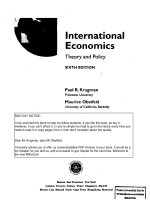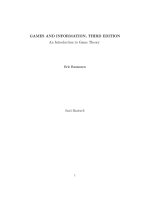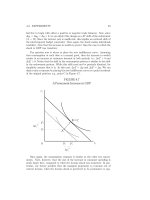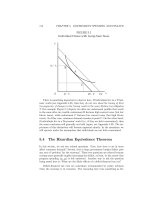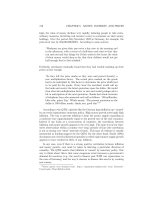Monetary theory and policy 3rd ed carl e walsh
Bạn đang xem bản rút gọn của tài liệu. Xem và tải ngay bản đầy đủ của tài liệu tại đây (2.81 MB, 639 trang )
Monetary
Theory
and Policy
third edition
Carl E. Walsh
Monetary Theory and Policy
Monetary Theory and Policy
Third Edition
Carl E. Walsh
The MIT Press
Cambridge
Massachusetts
6 2010 Massachusetts Institute of Technology
All rights reserved. No part of this book may be reproduced in any form by any electronic or mechanical
means (including photocopying, recording, or information storage and retrieval) without permission in
writing from the publisher.
For information about special quantity discounts, please email
This book was set in Times New Roman on 3B2 by Asco Typesetters, Hong Kong.
Printed and bound in the United States of America.
Library of Congress Cataloging-in-Publication Data
Walsh, Carl E.
Monetary theory and policy / Carl E. Walsh. — 3rd ed.
p. cm.
Includes bibliographical references and index.
ISBN 978-0-262-01377-2 (hardcover : alk. paper) 1. Monetary policy. 2. Money. I. Title.
HG230.3.W35 2010
2009028431
332.4 0 6—dc22
10 9 8 7
6 5 4 3
2 1
Contents
Preface
Introduction
xi
xvii
1
Empirical Evidence on Money, Prices, and Output
1.1 Introduction
1.2 Some Basic Correlations
1.2.1 Long-Run Relationships
1.2.2 Short-Run Relationships
1.3 Estimating the E¤ect of Money on Output
1.3.1 The Evidence of Friedman and Schwartz
1.3.2 Granger Causality
1.3.3 Policy Uses
1.3.4 The VAR Approach
1.3.5 Structural Econometric Models
1.3.6 Alternative Approaches
1.4 Summary
1
1
1
1
4
9
10
14
15
18
27
28
31
2
Money-in-the-Utility Function
2.1 Introduction
2.2 The Basic MIU Model
2.2.1 Steady-State Equilibrium
2.2.2 Steady States with a Time-Varying Money Stock
2.2.3 The Interest Elasticity of Money Demand
2.2.4 Limitations
2.3 The Welfare Cost of Inflation
2.4 Extensions
2.4.1 Interest on Money
2.4.2 Nonsuperneutrality
2.5 Dynamics in an MIU Model
33
33
35
41
46
48
52
53
58
58
59
61
vi
Contents
2.6
2.7
2.8
2.5.1 The Decision Problem
2.5.2 The Steady State
2.5.3 The Linear Approximation
2.5.4 Calibration
2.5.5 Simulation Results
Summary
Appendix: Solving the MIU Model
2.7.1 The Linear Approximation
2.7.2 Collecting All Equations
2.7.3 Solving Linear Rational-Expectations Models with
Forward-Looking Variables
Problems
62
65
66
71
72
75
76
78
85
86
87
3
Money and Transactions
3.1 Introduction
3.2 Resource Costs of Transacting
3.2.1 Shopping-Time Models
3.2.2 Real Resource Costs
3.3 CIA Models
3.3.1 The Certainty Case
3.3.2 A Stochastic CIA Model
3.4 Search
3.5 Summary
3.6 Appendix: The CIA Approximation
3.6.1 The Steady State
3.6.2 The Linear Approximation
3.7 Problems
91
91
92
92
97
98
99
108
115
126
126
127
128
130
4
Money and Public Finance
4.1 Introduction
4.2 Budget Accounting
4.2.1 Intertemporal Budget Balance
4.3 Money and Fiscal Policy Frameworks
4.4 Deficits and Inflation
4.4.1 Ricardian and (Traditional) Non-Ricardian Fiscal
Policies
4.4.2 The Government Budget Constraint and the Nominal
Rate of Interest
4.4.3 Equilibrium Seigniorage
4.4.4 Cagan’s Model
4.4.5 Rational Hyperinflation
135
135
136
141
142
144
146
150
152
156
159
Contents
4.5
vii
The Fiscal Theory of the Price Level
4.5.1 Multiple Equilibria
4.5.2 The Fiscal Theory
Optimal Taxation and Seigniorage
4.6.1 A Partial Equilibrium Model
4.6.2 Optimal Seigniorage and Temporary Shocks
4.6.3 Friedman’s Rule Revisited
4.6.4 Nonindexed Tax Systems
Summary
Problems
162
163
165
170
171
174
175
188
191
191
5
Money in the Short Run: Informational and Portfolio Rigidities
5.1 Introduction
5.2 Informational Frictions
5.2.1 Imperfect Information
5.2.2 The Lucas Model
5.2.3 Sticky Information
5.2.4 Learning
5.3 Limited Participation and Liquidity E¤ects
5.3.1 A Basic Limited-Participation Model
5.3.2 Endogenous Market Segmentation
5.3.3 Assessment
5.4 Summary
5.5 Appendix: An Imperfect-Information Model
5.6 Problems
195
195
196
196
197
203
207
209
211
215
218
218
219
223
6
Money in the Short Run: Nominal Price and Wage Rigidities
6.1 Introduction
6.2 Sticky Prices and Wages
6.2.1 An Example of Nominal Rigidities in General
Equilibrium
6.2.2 Early Models of Intertemporal Nominal Adjustment
6.2.3 Imperfect Competition
6.2.4 Time-Dependent Pricing (TDP) Models
6.2.5 State-Dependent Pricing (SDP) Models
6.2.6 Summary on Models of Price Adjustment
6.3 Assessing Alternatives
6.3.1 Microeconomic Evidence
6.3.2 Evidence on the New Keynesian Phillips Curve
6.3.3 Sticky Prices versus Sticky Information
6.4 Summary
225
225
225
4.6
4.7
4.8
226
231
234
237
243
249
250
250
252
261
262
viii
Contents
6.5
6.6
Appendix: A Sticky Wage MIU Model
Problems
262
264
7
Discretionary Policy and Time Inconsistency
7.1 Introduction
7.2 Inflation under Discretionary Policy
7.2.1 Policy Objectives
7.2.2 The Economy
7.2.3 Equilibrium Inflation
7.3 Solutions to the Inflation Bias
7.3.1 Reputation
7.3.2 Preferences
7.3.3 Contracts
7.3.4 Institutions
7.3.5 Targeting Rules
7.4 Is the Inflation Bias Important?
7.5 Summary
7.6 Problems
269
269
271
271
273
275
283
284
297
301
307
309
316
323
323
8
New Keynesian Monetary Economics
8.1 Introduction
8.2 The Basic Model
8.2.1 Households
8.2.2 Firms
8.3 A Linearized New Keynesian Model
8.3.1 The Linearized Phillips Curve
8.3.2 The Linearized IS Curve
8.3.3 Uniqueness of the Equilibrium
8.3.4 The Monetary Transmission Mechanism
8.3.5 Adding Economic Disturbances
8.3.6 Sticky Wages and Prices
8.4 Monetary Policy Analysis in New Keynesian Models
8.4.1 Policy Objectives
8.4.2 Policy Trade-o¤s
8.4.3 Optimal Commitment and Discretion
8.4.4 Commitment to a Rule
8.4.5 Endogenous Persistence
8.4.6 Targeting Regimes and Instrument Rules
8.4.7 Model Uncertainty
8.5 Summary
8.6 Appendix
329
329
330
331
333
336
336
339
341
344
347
351
352
352
355
357
364
366
370
375
378
379
Contents
8.7
9
10
ix
8.6.1 The New Keynesian Phillips Curve
8.6.2 Approximating Utility
Problems
379
381
387
Money and the Open Economy
9.1 Introduction
9.2 The Obstfeld-Rogo¤ Two-Country Model
9.2.1 The Linear Approximation
9.2.2 Equilibrium with Flexible Prices
9.2.3 Sticky Prices
9.3 Policy Coordination
9.3.1 The Basic Model
9.3.2 Equilibrium with Coordination
9.3.3 Equilibrium without Coordination
9.4 The Small Open Economy
9.4.1 Flexible Exchange Rates
9.4.2 Fixed Exchange Rates
9.5 Open-Economy Models with Optimizing Agents and Nominal
Rigidities
9.5.1 A Model of the Small Open Economy
9.5.2 The Relationship to the Closed-Economy NK Model
9.5.3 Imperfect Pass-Through
9.6 Summary
9.7 Appendix
9.7.1 The Obstfeld-Rogo¤ Model
9.7.2 The Small-Open-Economy Model
9.8 Problems
395
395
396
400
401
408
413
414
418
419
422
424
427
Financial Markets and Monetary Policy
10.1 Introduction
10.2 Interest Rates and Monetary Policy
10.2.1 Interest Rate Rules and the Price Level
10.2.2 Interest Rate Policies in General Equilibrium
10.2.3 Liquidity Traps
10.3 The Term Structure of Interest Rates
10.3.1 The Expectations Theory of the Term Structure
10.3.2 Policy and the Term Structure
10.3.3 Expected Inflation and the Term Structure
10.4 Macrofinance
10.5 Financial Frictions in Credit Markets
453
453
453
454
457
461
465
465
468
473
475
477
429
430
440
442
443
444
444
447
449
x
Contents
10.6
10.7
10.8
11
10.5.1 Adverse Selection
10.5.2 Moral Hazard
10.5.3 Monitoring Costs
10.5.4 Agency Costs
10.5.5 Macroeconomic Implications
Does Credit Matter?
10.6.1 The Bank Lending Channel
10.6.2 The Broad Credit Channel
Summary
Problems
479
483
484
489
492
502
504
507
508
509
Monetary Policy Operating Procedures
11.1 Introduction
11.2 From Instruments to Goals
11.3 The Instrument Choice Problem
11.3.1 Poole’s Analysis
11.3.2 Policy Rules and Information
11.3.3 Intermediate Targets
11.3.4 Real E¤ects of Operating Procedures
11.4 Operating Procedures and Policy Measures
11.4.1 Money Multipliers
11.4.2 The Reserve Market
11.4.3 A Simple Model of a Channel System
11.5 A Brief History of Fed Operating Procedures
11.5.1 1972–1979
11.5.2 1979–1982
11.5.3 1982–1988
11.5.4 After 1988
11.6 Other Countries
11.7 Problems
511
511
512
513
513
518
521
529
530
531
533
543
547
548
549
551
552
553
555
References
Name Index
Subject Index
559
597
605
Preface
This book covers the most important topics in monetary economics and some of the
models that economists have employed as they attempt to understand the interactions between real and monetary factors. It deals with topics in both monetary theory
and monetary policy and is designed for second-year graduate students specializing
in monetary economics, for researchers in monetary economics wishing to have a
systematic summary of recent developments, and for economists working in policy
institutions such as central banks. It can also be used as a supplement for first-year
graduate courses in macroeconomics because it provides a more in-depth treatment
of inflation and monetary policy topics than is customary in graduate macroeconomic textbooks. The chapters on monetary policy may be useful for advanced
undergraduate courses.
In preparing the third edition of Monetary Theory and Policy, my objective has
been to incorporate some of the new models, approaches, insights, and lessons that
monetary economists have developed in recent years. As with the second edition, I
have revised every chapter, with the goal of improving the exposition and incorporating new research contributions. At the time of the first edition, the use of models
based on dynamic optimization and nominal rigidities in consistent general equilibrium frameworks was still relatively new. By the time of the second edition, these
models had become the common workhorse for monetary policy analysis. And since
the second edition appeared, these models have continued to provide the theoretical
framework for most monetary analysis. They now also provide the foundation for
empirical models that have been estimated for a number of countries, with many
central banks now employing or developing dynamic stochastic general equilibrium
(DSGE) models that build on the new Keynesian models covered in earlier editions.
This third edition incorporates new or expanded material on money in search equilibria, sticky information, adaptive learning, state-contingent pricing models, and
channel systems of implementing monetary policy, among other topics. In addition,
much of the material on models for policy analysis has been reorganized to reflect the
dominance of the new Keynesian approach.
xii
Preface
In the introduction to the first edition, I cited three innovations of the book: the
use of calibration and simulation techniques to evaluate the quantitative significance
of the channels through which monetary policy and inflation a¤ect the economy; a
stress on the need to understand the incentives facing central banks and to model
the strategic interactions between the central bank and the private sector; and the
focus on interest rates in the discussion of monetary policy. All three aspects remain
in the current edition, but each is now commonplace in monetary research. For example, it is rare today to see research that treats monetary policy in terms of money
supply control, yet this was common well into the 1990s.
When one is writing a book like this, several organizational approaches present
themselves. Monetary economics is a large field, and one must decide whether to provide broad coverage, giving students a brief introduction to many topics, or to focus
more narrowly and in more depth. I have chosen to focus on particular models,
models that monetary economists have employed to address topics in theory and
policy. I have tried to stress the major topics within monetary economics in order to
provide su‰ciently broad coverage of the field, but the focus within each topic is
often on a small number of papers or models that I have found useful for gaining insight into a particular issue. As an aid to students, derivations of basic results are
often quite detailed, but deeper technical issues of existence, multiple equilibria, and
stability receive somewhat less attention. This choice was not made because the latter
are unimportant. Instead, the relative emphasis reflects an assessment that to do
these topics justice, while still providing enough emphasis on the core insights o¤ered
by monetary economics, would have required a much longer book. By reducing the
dimensionality of problems and by not treating them in full generality, I hoped to
achieve the right balance of insight, accessibility, and rigor. The many references
will serve to guide students to the extensive treatments in the literature of all the
topics touched upon in this book.
While new material has been added, and some material has been deleted, the organization of chapters 1–4 is similar to that of the second edition. Significant changes
have been made to each of these chapters, however. Chapter 2 includes a discussion
of steady states with a time-varying stock of money; and the empirical evidence on
money demand and the connection between the interest elasticity of money demand
and the costs of inflation are more fully discussed. The first-order conditions for the
household’s decision problem in the stochastic MIU model have been moved from
an appendix into the text; the calibration for the simulation exercises has changed;
and programs are provided (at h for solving
the stochastic MIU model using eigenvalue decomposition methods based on the
programs of Harald Uhlig, Paul So¨derlind, and Dynare as well as for employing an
approach based on a linear regulator problem. Because Uhlig’s tool kit is not the
only approach used, the discussion of his methodology has been shortened.
Preface
xiii
Similar changes with regard to the simulation programs have been made for the
CIA model of chapter 3. In addition, the timing of the asset and goods markets has
been changed for the model used to study dynamics. Asset markets now open first,
which ensures that the cash-in-advance constraint always holds as long as the nominal interest rate is positive. The major change to chapter 3 is the extended discussion
of the literature on money in search equilibrium. Less detail is now provided on the
Kiyotaki and Wright (1989) model; instead, the main focus is on the model of Lagos
and Wright (2005).
Chapter 4 has been shortened by eliminating some of the discussion of time series
methods for testing budget sustainability.
Chapters 5–11 have seen a major revision. Chapters 5 and 6 focus on the frictions
that account for the short-run impact of monetary policy. In previous editions, this
material was entirely contained in chapter 5. Given the enormous growth in the literature on topics like sticky information and state-dependent pricing models, the third
edition devotes two chapters to the topic of frictions. Chapter 5 focuses on models
with information rigidities, such as Lucas’s island model and models of sticky information. It also discusses models based on portfolio frictions, such as limitedparticipation and asset-market-segmentation models. More formal development of a
limited-participation model is provided, and a model of endogenous asset market
segmentation is discussed. Chapter 6 focuses on nominal wage and price stickiness,
and incorporates recent work on microeconomic evidence for price adjustment and
research on state-contingent pricing models. The third edition focuses less on the
issue of persistence in evaluating the new Keynesian Phillips curve but provides
expanded coverage of empirical assessments of models of sticky prices, particularly
related to the micro evidence now available.
Models of the average inflation bias of discretionary policy are discussed in chapter 7. Chapter 8 provides stand-alone coverage of new Keynesian models and their
policy implications in the context of the closed economy. It incorporates material
formerly split between chapters 5 and 11 of the second edition. The open economy
is now the focus of chapter 9. Chapter 10 on credit frictions now includes a new
section on macrofinance models as well as material on the term structure from the
second edition. Finally, chapter 11, on operating procedures, has taken on a new relevance and provides a discussion of channel systems for implementing monetary
policy.
It is not possible to discuss here all the areas of monetary economics in which
economists are pursuing active research, or to give adequate credit to all the interesting work that has been done. The topics covered and the space devoted to them
reflect my own biases toward research motivated by policy questions or influential
in a¤ecting the conduct of monetary policy. The field has simply exploded with new
and interesting research, and at best this edition, like the earlier ones, can only
xiv
Preface
scratch the surface of many topics. To those whose research has been slighted, I o¤er
my apologies.
Previous editions were immensely improved by the thoughtful comments of many
individuals who took the time to read parts of earlier drafts, and I have received
many comments from users of the first two editions, which have guided me in revising the material. Luigi Buttiglione, Marco Hoeberichts, Michael Hutchison,
Francesco Lippi, Jaewoo Lee, Doug Pearce, Gustavo Piga, Glenn Rudebusch, Willem
Verhagen, and Chris Waller provided many insightful and useful comments on the
first edition. Students at Stanford and the University of California, Santa Cruz
(UCSC) gave important feedback on draft material; Peter Kriz, Jerry McIntyre,
Fabiano Schivardi, Alina Carare, and especially Jules Leichter deserve special mention. A very special note of thanks is due Lars Svensson and Berthold Herrendorf.
Each made extensive comments on complete drafts of the first edition. Attempting
to address the issues they raised greatly improved the final product; it would have
been even better if I had had the time and energy to follow all their suggestions.
The comments and suggestions of Julia Chiriaeva, Nancy Jianakoplos, Stephen
Miller, Jim Nason, Claudio Shikida, and participants in courses I taught based on
the first edition at the IMF Institute, the Bank of Spain, the Bank of Portugal, the
Bank of England, the University of Oslo, and the Swiss National Bank Studienzentrum Gerzensee all contributed to improving the second edition. Wei Chen, Ethel
Wang, and Jamus Lim, graduate students at UCSC, also o¤ered helpful comments
and assistance in preparing the second edition.
I would like particularly to thank Henning Bohn, Betty Daniel, Jordi Galı´, Eric
Leeper, Tim Fuerst, Ed Nelson, Federico Ravenna, and Kevin Salyer for very helpful comments on early drafts of some chapters of the second edition. Many of the
changes appearing in the third edition are the result of comments and suggestions
from students and participants at intensive courses in monetary economics that I
taught at the IMF Institute, the Swiss National Bank Studienzentrum Gerzensee,
the Central Bank of Brazil, the University of Rome ‘‘Tor Vergata,’’ the Norges
Bank Training Program for Economists, the Finnish Post-Graduate Program in Economics, the ZEI Summer School, and the Hong Kong Institute for Monetary Research. Students at UCSC also contributed, and Conglin Xu provided excellent
research assistance during the process of preparing this edition.
Henrik Jenson read penultimate versions of many of the current chapters and provided a host of useful suggestions that helped improve the book in terms of substance
and clarity. Others I would like to thank, whose suggestions have improved this edition, include Ulf So¨derstro¨m, Mario Nigrinis, Stephen Sauer, Sendor Lczel, Jizhong
Zhou (who translated the second edition into Chinese), Oreste Tristani, Robert
Tchaidze, Teresa Simo˜es, David Coble Ferna´ndez, David Florian-Hoyle, Jonathan
Benchimol, Carlo Migliardo, Oliver Fries, Yuichiro Waki, Cesar Carrera, Federico
Preface
xv
´ lvaro Pina, and Paul So¨derlind (and
Guerrero, Beka Lamazoshvili, Rasim Mutlu, A
my apologies to anyone I have failed to mention). As always, remaining errors are
my own.
I would also like to thank Jane Macdonald, my editor at the MIT Press for the
third edition, Nancy Lombardi, production editor for both the first and second editions, and Deborah Cantor-Adams, production editor, and Alice Cheyer, copy editor, for this edition, for their excellent assistance on the manuscript. Needless to say,
all remaining weaknesses and errors are my own responsibility. Terry Vaughan, my
original editor at the MIT Press, was instrumental in ensuring this project got o¤ the
ground initially, and Elizabeth Murry served ably as editor for the second edition.
Introduction
Monetary economics investigates the relationship between real economic variables at
the aggregate level (such as real output, real rates of interest, employment, and real
exchange rates) and nominal variables (such as the inflation rate, nominal interest
rates, nominal exchange rates, and the supply of money). So defined, monetary economics has considerable overlap with macroeconomics more generally, and these
two fields have to a large degree shared a common history over most of the past 50
years. This statement was particularly true during the 1970s after the monetarist/
Keynesian debates led to a reintegration of monetary economics with macroeconomics. The seminal work of Robert Lucas (1972) provided theoretical foundations for
models of economic fluctuations in which money was the fundamental driving factor
behind movements in real output. The rise of real-business-cycle models during the
1980s and early 1990s, building on the contribution of Kydland and Prescott (1982)
and focusing explicitly on nonmonetary factors as the driving forces behind business
cycles, tended to separate monetary economics from macroeconomics. More recently,
the real-business-cycle approach to aggregate modeling has been used to incorporate
monetary factors into dynamic general equilibrium models. Today, macroeconomics
and monetary economics share the common tools associated with dynamic stochastic
approaches to modeling the aggregate economy.
Despite these close connections, a book on monetary economics is not a book
on macroeconomics. The focus in monetary economics is distinct, emphasizing price
level determination, inflation, and the role of monetary policy. Today, monetary
economics is dominated by three alternative modeling strategies. The first two,
representative-agent models and overlapping-generations models, share a common
methodological approach in building equilibrium relationships explicitly on the foundations of optimizing behavior by individual agents. The third approach is based on
sets of equilibrium relationships that are often not derived directly from any decision
problem. Instead, they are described as ad hoc by critics and as convenient approximations by proponents. The latter characterization is generally more appropriate,
and these models have demonstrated great value in helping economists understand
xviii
Introduction
issues in monetary economics. This book deals with models in the representativeagent class and with ad hoc models of the type often used in policy analysis.
There are several reasons for ignoring the overlapping-generations (OLG) approach. First, systematic expositions of monetary economics from the perspective
of overlapping generations are already available. For example, Sargent (1987) and
Champ and Freeman (1994) covered many topics in monetary economics using
OLG models. Second, many of the issues one studies in monetary economics require understanding the time series behavior of macroeconomic variables such as
inflation or the relationship between money and business cycles. It is helpful if the
theoretical framework can be mapped directly into implications for behavior that
can be compared with actual data. This mapping is more easily done with infinitehorizon representative-agent models than with OLG models. This advantage, in
fact, is one reason for the popularity of real-business-cycle models that employ the
representative-agent approach, and so a third reason for limiting the coverage to
representative-agent models is that they provide a close link between monetary economics and other popular frameworks for studying business cycle phenomena.
Fourth, monetary policy issues are generally related to the dynamic behavior of the
economy over time periods associated with business cycle frequencies, and here again
the OLG framework seems less directly applicable. Finally, OLG models emphasize
the store-of-value role of money at the expense of the medium-of-exchange role that
money plays in facilitating transactions. McCallum (1983b) argued that some of the
implications of OLG models that contrast most sharply with the implications of
other approaches (the tenuousness of monetary equilibria, for example) are directly
related to the lack of a medium-of-exchange role for money.
A book on monetary theory and policy would be seriously incomplete if it were
limited to representative-agent models. A variety of ad hoc models have played, and
continue to play, important roles in influencing the way economists and policymakers think about the role of monetary policy. These models can be very helpful
in highlighting key issues a¤ecting the linkages between monetary and real economic
phenomena. No monetary economist’s tool kit is complete without them. But it is
important to begin with more fully specified models so that one has some sense of
what is missing in the simpler models. In this way, one is better able to judge whether
the ad hoc models are likely to provide insight into particular questions.
This book is about monetary theory and the theory of monetary policy. Occasional references to empirical results are made, but no attempt has been made to
provide a systematic survey of the vast body of empirical research in monetary economics. Most of the debates in monetary economics, however, have at their root
issues of fact that can only be resolved by empirical evidence. Empirical evidence is
needed to choose between theoretical approaches, but theory is also needed to interpret empirical evidence. How one links the quantities in the theoretical model to
Introduction
xix
measurable data is critical, for example, in developing measures of monetary policy
actions that can be used to estimate the impact of policy on the economy. Because
empirical evidence aids in discriminating between alternative theories, it is helpful to
begin with a brief overview of some basic facts. Chapter 1 does so, providing a discussion that focuses primarily on the estimated impact of monetary policy actions on
real output. Here, as in the chapters that deal with some of the institutional details of
monetary policy, the evidence comes primarily from research on the United States.
However, an attempt has been made to cite cross-country studies and to focus on
empirical regularities that seem to characterize most industrialized economies.
Chapters 2–4 emphasize the role of inflation as a tax, using models that provide
the basic microeconomic foundations of monetary economics. These chapters cover
topics of fundamental importance for understanding how monetary phenomena affect the general equilibrium behavior of the economy and how nominal prices, inflation, money, and interest rates are linked. Because the models studied in these
chapters assume that prices are perfectly flexible, they are most useful for understanding longer-run correlations between inflation, money, and output and crosscountry di¤erences in average inflation. However, they do have implications for
short-run dynamics as real and nominal variables adjust in response to aggregate
productivity disturbances and random shocks to money growth. These dynamics are
examined by employing simulations based on linear approximations around the
steady-state equilibrium.
Chapters 2 and 3 employ a neoclassical growth framework to study monetary phenomena. The neoclassical model is one in which growth is exogenous and money has
no e¤ect on the real economy’s long-run steady state or has e¤ects that are likely to
be small empirically. However, because these models allow one to calculate the welfare implications of exogenous changes in the economic environment, they provide a
natural framework for examining the welfare costs of alternative steady-state rates of
inflation. Stochastic versions of the basic models are calibrated, and simulations are
used to illustrate how monetary factors a¤ect the behavior of the economy. Such
simulations aid in assessing the ability of the models to capture correlations observed
in actual data. Since policy can be expressed in terms of both exogenous shocks and
endogenous feedbacks from real shocks, the models can be used to study how economic fluctuations depend on monetary policy.
In chapter 4, the focus turns to public finance issues associated with money, inflation, and monetary policy. The ability to create money provides governments with a
means of generating revenue. As a source of revenue, money creation, along with the
inflation that results, can be analyzed from the perspective of public finance as one
among many tax tools available to governments.
The link between the dynamic general equilibrium models of chapters 2–4 and the
models employed for short-run and policy analysis is developed in chapters 5 and 6.
xx
Introduction
Chapter 5 discusses information and portfolio rigidities, and chapter 6 focuses on
nominal rigidities that can generate important short-run real e¤ects of monetary policy. Chapter 5 begins by reviewing some attempts to replicate the empirical evidence
on the short-run e¤ects of monetary policy shocks while still maintaining the assumption of flexible prices. Lucas’s misperceptions model provides an important example of one such attempt. Models of sticky information with flexible prices, due to
the work of Mankiw and Reis, provide a modern approach that can be thought of
as building on Lucas’s original insight that imperfect information is important for
understanding the short-run e¤ects of monetary shocks. Despite the growing research
on sticky information and on models with portfolio rigidities (also discussed in chapter 5), it remains the case that most research in monetary economics in recent years
has adopted the assumption that prices and/or wages adjust sluggishly in response to
economic disturbances. Chapter 6 discusses some important models of price and inflation adjustment, and reviews some of the new microeconomic evidence on price
adjustment by firms. This evidence is helping to guide research on nominal rigidities
and has renewed interest in models of state-contingent pricing.
Chapter 7 turns to the analysis of monetary policy, focusing on monetary policy
objectives and the ability of policy authorities to achieve these objectives. Understanding monetary policy requires an understanding of how policy actions a¤ect
macroeconomic variables (the topic of chapters 2–6), but it also requires models of
policy behavior to understand why particular policies are undertaken. A large body
of research over the past three decades has used game-theoretic concepts to model
the monetary policymaker as a strategic agent. These models have provided new
insights into the rules-versus-discretion debate, provided positive theories of inflation,
and provided justification for many of the actual reforms of central banking legislation that have been implemented in recent years.
Models of sticky prices in dynamic stochastic general equilibrium form the foundation of the new Keynesian models that have become the standard models for
monetary policy analysis over the past decade. These models build on the joint foundations of optimizing behavior by economic agents and nominal rigidities, and they
form the core material of chapter 8. The basic new Keynesian model and some of its
policy implications are explored.
Chapter 9 extends the analysis to the open economy by focusing on two questions.
First, what additional channels from monetary policy actions to the real economy
are present in the open economy that were absent in the closed-economy analysis?
Second, how does monetary policy a¤ect the behavior of nominal and real exchange
rates? New channels through which monetary policy actions are transmitted to the
real economy are present in open economies and involve exchange rate movements
and interest rate linkages.
Introduction
xxi
Traditionally, economists have employed simple models in which the money stock
or even inflation is assumed to be the direct instrument of policy. In fact, most central banks have employed interest rates as their operational policy instrument, so
chapter 10 emphasizes the role of the interest rate as the instrument of monetary policy and the term structure that links policy rates to long-term interest rates. While the
channels of monetary policy emphasized in traditional models operate primarily
through interest rates and exchange rates, an alternative view is that credit markets
play an independent role in a¤ecting the transmission of monetary policy actions
to the real economy. The nature of credit markets and their role in the transmission process are a¤ected by market imperfections arising from imperfect information, so chapter 10 also examines theories that stress the role of credit and credit
market imperfections in the presence of moral hazard, adverse selection, and costly
monitoring.
Finally, in chapter 11 the focus turns to monetary policy implementation. Here,
the discussion deals with the problem of monetary instrument choice and monetary
policy operating procedures. A long tradition in monetary economics has debated
the usefulness of monetary aggregates versus interest rates in the design and implementation of monetary policy, and chapter 11 reviews the approach economists have
used to address this issue. A simple model of the market for bank reserves is used to
stress how the observed responses of short-term interest rates and reserve aggregates
will depend on the operating procedures used in the conduct of policy. New material
on channel systems for interest rate control has been added in this edition. A basic
understanding of policy implementation is important for empirical studies that attempt to measure changes in monetary policy.1
1. Central bank operating procedures have changed significantly in recent years. For example, the Federal
Reserve now employs a penalty rate on discount window borrowing and pays interest on reserves. Several
other central banks employ channel systems (see section 11.4.3). For these reasons, the reserve market
model discussed in the first two editions, based as it was on a zero interest rate on reserves and a nonpenalty discount rate, is less relevant. However, because the previous model may still be of interest to some
readers, section 9.4 of the second edition is available online at h />
Monetary Theory and Policy
